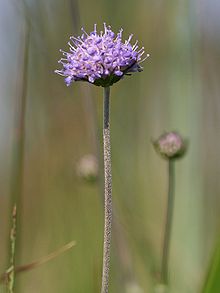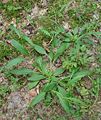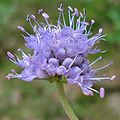- Succisa pratensis
-
Succisa pratensis 
Scientific classification Kingdom: Plantae (unranked): Angiosperms (unranked): Eudicots (unranked): Asterids Order: Dipsacales Family: Dipsacaceae Genus: Succisa Species: S. pratensis Binomial name Succisa pratensis Succisa pratensis Moench, also known as Devil's-bit Scabious, is a flowering plant of the genus Succisa in the family Dipsacaceae. It differs from other similar species in that it has 4 lobed flowers, whereas Small Scabious and Field scabious have 5 lobes and hence it has been placed in a separate genus in the same family[1]. It also grows on damper ground[2].
Its leaves are also un-lobed unlike Field scabious[3], and are arranged in opposite pairs. The leaves and plant can be confused with Greater Knapweed however Knapweed has leaves that are alternate, not opposite.
It prefers moist soil - damp meadows and woods, lowland heath, marshy areas; but will tolerate drier conditions. Male and female flowers are produced on different heads, the female being smaller[4]. Flowers from June until October.
It is a good source of nectar and is the foodplant of Marsh fritillary, whose eggs are laid in groups on the underside of the plant, and Narrow-bordered Bee Hawk-moth Hemaris tityus. As both plant and invertebrates are rare, their survival relies on careful management of sites containing these species.
Name
Species of scabious were used to treat Scabies, and other afflictions of the skin including sores caused by the Bubonic Plague[5]. The word scabies comes from the Latin word for "scratch" (scabere). The short black root was in folk tales bitten off by the devil, angry at the plant's ability to cure these ailments[6], in anger against the Virgin Mary[7], or as part of some 'devilish plot'[8].
Management
The aim is to produce an uneven patchwork of short and long vegetation by the end of the grazing period, between 8 and 25 cm. This is to allow the Devil's Bit Scabious food plant to grow.
This can be achieved through low intensity grazing (also known as extensive grazing) using cattle. Sheep are not so good as they are more efficient at removing wild plants.
-
Succisa pratensis on the german island Hiddensee,
Photo by Kristian Peters
References
- ^ Wild Flowers of Britain and Ireland by Rae Spencer Jones and Sarah Cuttle
- ^ The Illustrated Wild Flower Finder's Calendar
- ^ Usborne Spotter's Handbook of Birds, Trees, Wildflowers
- ^ A photographic guide to Wildflowers of Britain and Europe by Paul Sterry and Bob Press
- ^ Kingfisher Field Guides - Wild Flowers of Britain and Northern Europe
- ^ The I-Spy Guide to Wild Flowers by Michelin
- ^ Wild Flowers of Britain by Roger Phillips
- ^ Wild Flowers of Britain and Ireland by Marjorie Blamey, Richard Fitter, Alastair Fitter
Categories:
Wikimedia Foundation. 2010.






